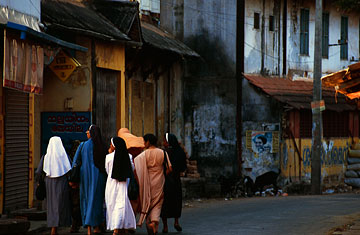
A group of Catholic nuns walking in Kerala, India
(2 of 2)
Recently, there have been expulsions and other disciplinary action in response to other cases of misconduct within the church in Kerala. In June last year, a nun in a Christian hospital was expelled after a video of her having sex with a driver was circulated over mobile phones and the Internet. In October, Pope Benedict XVI suspended a bishop in the coastal city of Cochin after his adoption of a 26-year-old woman as his daughter raised questions. The bishop has denied any wrongdoing and said he adopted the woman out of fatherly love. But the church took him off all duties and instituted an inquiry.
"Such problems have been there in almost all convents [in Kerala]," says Joseph Pulikunnel, a veteran Syrian Catholic social reformer who edits Osanna, a magazine aimed at Kerala's Catholic community. "The convents are closed to the public. We don't know what is happening inside." He says India's Catholic Church, which accounts for 70% of all denominations among India's 25 million Christians, owns vast properties across the country, including over 30,000 educational institutions and 6,000 hospitals. In Kerala, the Church runs 60% of the private educational institutes. The state's near 100% literacy — a singular case in a country where the average adult literacy rate is just about 60% — is thanks largely to the church's zealous missionary activity. Yet critics claim this gives the church a high degree of political and economic power. Church-reform activists also say the affairs of the Catholic Church — to which 60% of Kerala's Christians belong — should be brought more directly under the control of Indian authorities to make its workings more transparent. As of now, church affairs are under the stewardship of the Pope. (See pictures of spiritual healing around the world.)
In recent months, the church has been more forthcoming about the problems it faces. Sathyadeepam, Kerala's Catholic weekly, released a report in January that said almost 20% of the region's nuns — the church says there are about 45,000 — feel "insecure or unaccepted" in their convents. Cases of nuns speaking up like Raphael are still rare, but there may be an avalanche building up due to the changing social scene. Earlier, girls from disadvantaged families embraced the vows, finding that life in a convent, while hard, saved them from the worst of deprivation. But once in an order, they found it difficult to complain or leave. "They simply had nowhere to go," says Pulikunnel. "If they quit the convent, they'd be thrown out penniless, and their families wouldn't take them back."
But times have changed. Churches around the world have been coming to grips with legacies of quiet abuse, and Indian society, too, has evolved. There is no longer a stigma attached to giving up the robes and returning to the laity. There are plenty of well-paying jobs — nursing has proven particularly attractive for Kerala women, as it is seen as a passport to a foreign post and big bucks — and many youngsters are not up for a lifetime of celibacy and a religious vocation. And though figures have not been collated, activists claim a steady decline in the number of young people taking the vows or, like Raphael, renouncing them altogether.
But to stem the rot that has set in, the church will first have to admit the real nature and extent of the problem. If Alathara's reaction is anything to go by, that candor is a long way off. When asked about the numerous allegations of sexual abuse in the church, he said, "[Alleging sexual abuse] is an old tool of hitting at the ecclesiastical society. It's nothing new. It happened 2,000 years ago too." Father Thelakkat's reaction is somewhat similar. Though he doesn't deny Raphael's allegations, he refuses to acknowledge their seriousness either: "The incidents may be true, but they are isolated cases." Clearly, it's time to connect the dots and see the bigger picture.
